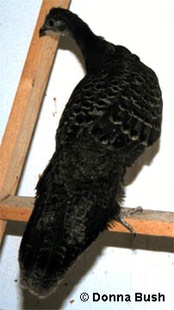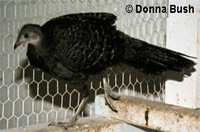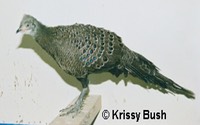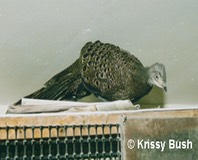Scientific Information
Class: Aves
Order: Galliformes
Family: Phasianidae
Subfamily: Phasianinae
Genus: Polyplectron
Species: bicalcaratum
Species English name: Grey Peacock Pheasant
CITES Status: not listed
Distribution: Extensive - Southeast Asia
(from A Monograph of Pheasants Volumes I & II, William Beebe)
****Are not a true Pheasant Species****
Description
• Both Sexes: Same, but males are slightly larger. Overall grey colour with darker grey barring and metallic blue/purple/green circles on ends of wing and tail feathers. White face and chin, grey beak & legs.
• Very small bird underneath all of those feathers.
Diet
• We feed our breeders and young adults 16% layer pellets and 20% crumble, our tiny chicks 25% Turkey Starter crumble, and our growing chicks 20% crumble.
• They get fresh greens (lettuce, chickweed, dandelions, grass) and fruits (tomato, grapes, berries, etc.) when available but they are not big on treats.
Breeding
• Done in pairs.
• Grey Peacocks are second year birds meaning that the female will lay eggs two springs after she is hatched and the male is not fertile until his second or third spring.
• Grey Peacocks are greatly inbred in North America and there are fertility issues with the males
• If they are put on light, they start laying eggs usually in February and will lay sporadically until they lay up to ~ 10 eggs.
• They lay a small creamy egg.
Incubation
• Eggs are collected twice a day and marked with the date and breeding pen number and set daily.
• Eggs are set in an automatic turning Lyons Roll-X (RX2) with grid 109 or in a Turn-X on a small pheasant egg grid.
• Temperature 99.8°F, humidity-wet bulb 84 with humidity adjusted periodically depending on development of the air space shown by candling
• On the final day of incubation, each egg is placed in its own oval wire mesh hatching basket (6" x 3" x 3") and set in the Sportsman Ratite hatcher.
• Incubation for Grey Peacocks is 22 days.
• After the chick hatches, it stays in the hatcher for a minimum of 8 hours.
Chicks
• Chicks a light creamy grey colour and are tall and leggy.
• They start out in our round 18" brooder pen with a mixed assortment of chicks. After a few days they are separated into a 2' x 4' baby pen for about a week. They can be raised with either ornamental quail or docile pheasants in 2' x 6' pens for the next 7-9 weeks. Once there are enough, they are put into a Grey Peacock only pen. They stay with this grouping until they are sold. All of these brooding pens have wire bottoms with a heat lamp at one end and feed & water at the other end. The heat lamp is attached to a dimmer switch so we can turn down the amount of heat as the chicks get older until it is turned off completely.
• After they are off of the heat for a few weeks, they are moved outside to the pheasant house (has outside grassy pens and a heated inside house part where they are blocked in for the night). After they are toughened up, they are moved to an outside chick pen.
• Chicks are easy to raise with their own kind, but are easily bullied by other chicks since Grey Peacock chicks are so docile.
Pens
• Breeding pens are 6 feet long x 2 feet wide x 1 foot high.
• Breeding may also be done in outside pens of any size.
Behavior
• Are calm and very quiet birds.
Article By Krissy & Donna Bush
Pheasant Ridge



